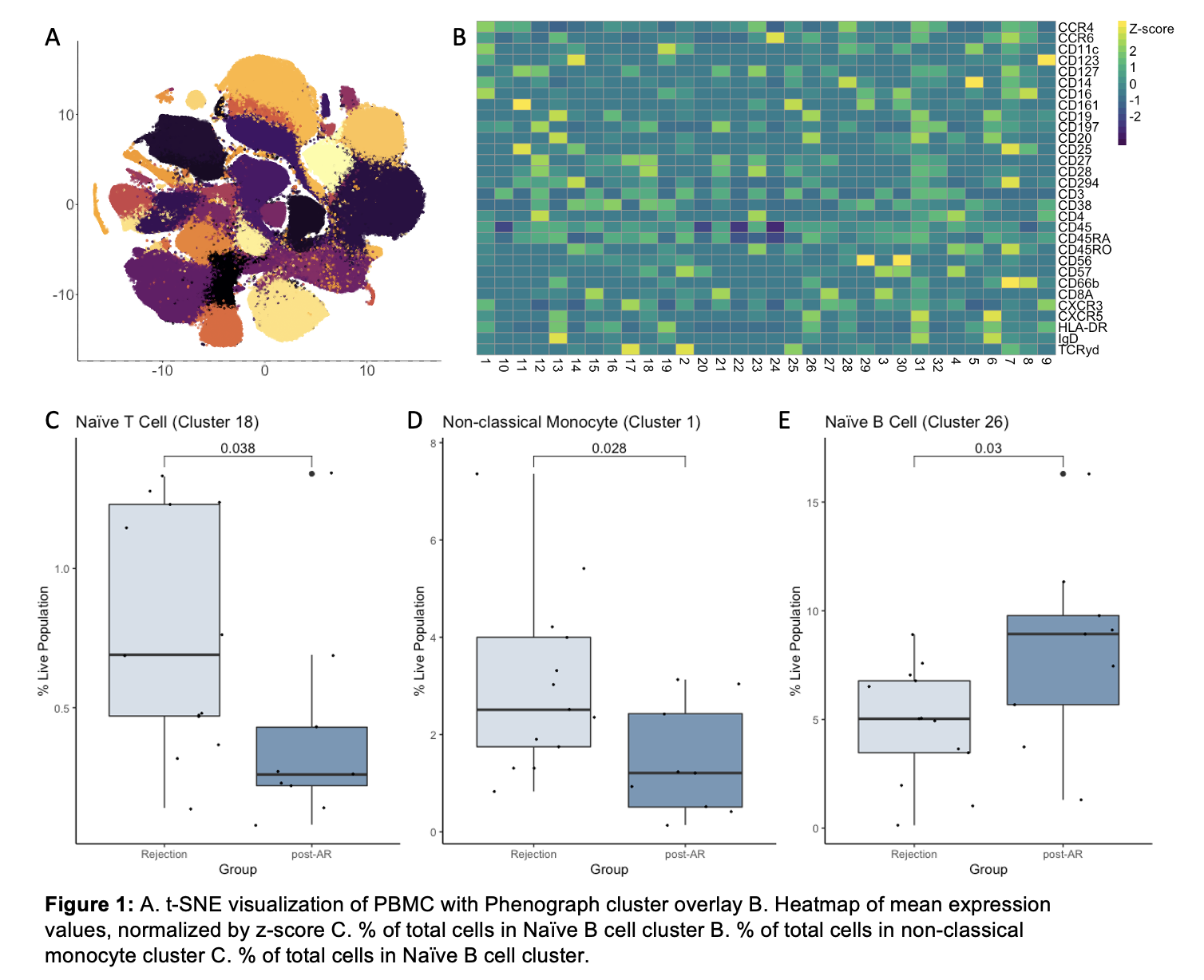Temporal Changes in the Peripheral Immune Profile of Acute Rejection Highlight New Mechanisms of Alloimmunity and Potential Non-Invasive Biomarkers of Rejection in Pediatric Liver Transplantation
1University of Southern California Keck School of Medicine, Los Angeles, CA, 2Children's Hospital Los Angeles, Los Angeles, CA
Meeting: 2022 American Transplant Congress
Abstract number: 371
Keywords: Autoimmunity, Biopsy, Graft survival, Liver transplantation
Topic: Basic Science » Basic Science » 02 - Acute Rejection
Session Information
Session Time: 5:30pm-7:00pm
 Presentation Time: 5:50pm-6:00pm
Presentation Time: 5:50pm-6:00pm
Location: Hynes Room 309
*Purpose: Acute rejection (AR) is common in pediatric liver transplantation (LT) and can impact late graft loss. Immune subpopulations mediating AR in LT have not been well characterized. This study aimed to use highly dimensional mass cytometry (CyTOF) to identify peripheral immune subpopulations involved in AR.
*Methods: Blood was collected from pediatric LT recipients at time of liver biopsy and at four weeks post-biopsy from the subgroup of patients with treated, biopsy proven AR (‘post-AR’) from July 2020 to September 2021. PBMCs were stained with a 32-marker immune CyTOF panel. Data were analyzed in R using tSNE and PhenoGraph and stratified by clinical outcome.
*Results: The study population included 15 patients with no AR and 13 patients with at least 3/9 AR. Unsupervised clustering of >370,000 cells identified 32 immune subpopulations (Fig. 1A & B). A naïve T-cell subpopulation, (CD3+/CD28+/CD27+) was upregulated during AR when compared to post-AR with lower expression of CXCR3 and CD57 (p=0.038, Fig. 1C). In addition, non-classical monocytes with antigen-presenting and TNFα secreting properties (CD14dim/CD16+/CD123dim) were upregulated during AR, with higher expression of CD11c and CD123 and less CCR4 (p=0.028, Fig. 1D). Interestingly, post-AR samples were enriched in naive B-cells (CD19+/CD20+/CD38–) when compared to AR (p=0.03, Fig. 1E). These cells expressed lower levels of CXCR5 and CCR6 post-AR.
*Conclusions: In this highly multiplexed, temporal analysis of peripheral immunity during AR in pediatric LT, several dominant subpopulations associated with AR were identified. Downregulation of a naïve T-cell subset following AR provides insight into mechanisms of alloimmunity and shows potential as a biomarker for resolution of AR. Similarly, an increase in naïve B-cells may be associated with resolution of AR. Complementary techniques are being explored to further correlate tissue-level alloimmunity with this peripheral dataset.
To cite this abstract in AMA style:
Sarode DN, Rocque B, Barbetta A, Singh P, Goldbeck C, Weaver C, Akbari O, Kohli R, Emamaullee J. Temporal Changes in the Peripheral Immune Profile of Acute Rejection Highlight New Mechanisms of Alloimmunity and Potential Non-Invasive Biomarkers of Rejection in Pediatric Liver Transplantation [abstract]. Am J Transplant. 2022; 22 (suppl 3). https://atcmeetingabstracts.com/abstract/temporal-changes-in-the-peripheral-immune-profile-of-acute-rejection-highlight-new-mechanisms-of-alloimmunity-and-potential-non-invasive-biomarkers-of-rejection-in-pediatric-liver-transplantation/. Accessed December 25, 2025.« Back to 2022 American Transplant Congress

